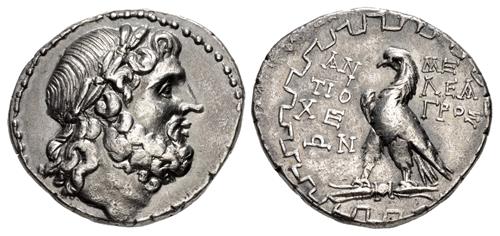|
CARIA, Antioch ad Maeandrum. Early-Mid 1st century BC. AR Tetradrachm (29mm, 15.87 g, 12h). Meleager, magistrate. Bearded head of Zeus right, wearing laurel wreath / Eagle, with closed wings, standing left on thunderbolt; AN/TIO/XE/ΩN to left, ME/ΛEA/ΓPOΣ to right; all within circular maeander pattern. Thonemann Group B, 7b (O7’/R16); HN Online 2226 (same dies as illustration); Nomos 17, lot 184 (hammer 36,000 CHF) = Gorny & Mosch 207, lot 358 (hammer €24,000; same dies). Toned. Good VF. Extremely rare, only four tetradrachms of Meleager noted by Thonemann.
The Carian city of Antioch, located near the eastern end of the Maeander valley, was founded on the south bank of the river Maeander, where the river is joined by a major tributary, the Morsynos River, flowing north from Aphrodisias. It was a Hellenistic settlement that was founded by Antiochos I Soter (though some argument has been advanced in favor of Antiochos III), and likely through a synoecism of two villages, Symmaithos and Kranaos (Pliny, NH 5.108). The location was a significant crossing point of the Common Road over the Maeander, between the important cities of Tralles, to the west, and Laodikeia on the Lykon, to the east. Given its important location, surprisingly little is known today about Antioch in the Hellenistic period; there is little mention of the city in contemporary literature and epigraphy, and the site remains unexcavated. In contrast, the city took on a much more important role in the Roman period, when it was fortified, and figured significantly in many emperors' eastern campaigns.
Its strategic location along a major trade route certainly must have enriched the city, which grew to a considerable size by the first century AD, spanning both sides of the Maeander (cf. Strabo 13.4.15). While the Roman provincial coinage at Antioch is quite sizable, the Hellenistic civic coinage is quite rare. All the civic issues date from the 2nd-1st centuries BC, and primarily consists of bronze coins, with very rare issues of silver tetradrachms and drachms. The types are fairly consistent across all denominations, with the obverse featuring the portrait of either Zeus, Apollo, Dionysos, or Artemis, while the reverse featuring a zebu bull or an eagle standing on a thunderbolt. Interestingly, some of the coins bear the name of a magistrate, while others do not.
The silver has traditionally been dated to the 2nd century BC, and may have begun with a couple of rare issues of Alexander type tetradrachms that M.J. Price (following H. Seyrig) tentatively placed there, circa 190-180 BC, but it is more likely that these Alexanders are actually issues of Tabai (cf. Price p. 311 and Thonemann p. 52). No Seleukid issues are currently attributed to Antioch, but there are many western issues that are unattributed from the reigns of Antiochos I through Antiochos III, so it is possible that some of these issues may actually belong to this city. Thonemann’s recent study of the city’s Hellenistic silver coinage convincingly places it in the early-mid 1st century BC. He notes that Antioch was one of many cities in their region that began striking silver around the same time, and some of those cities struck dated issues that firmly places them in this period. It also seems likely to him that all of these silver issues were struck in relation to the Mithradatic Wars; that their production was not for purely civic needs, that the silver was struck for the benefit of a more powerful entity, which was likely the Roman forces that were in the region to counter the Pontic threat. In fact, the weight standard of the Antioch silver, with a drachm at c. 3.90-3.96 grams, is compatible with the contemporary Roman denarius. Thonemann also notes that it is possible that Antioch may have received the status of a civitas libera from Sulla for services the city performed for Rome in the early 80s BC. In any case, the silver coinage of Antioch appears to Thonemann to be a “surrogate” Roman coinage, struck for military purposes. Unfortunately, there is still too little evidence to firmly anchor the dating of the coinage to any particular event(s), though it is clear that the coinage probably endured until the end of the Mithradatic Wars in 63 BC, if not shortly thereafter.
The final winners of all Triton XXIV lots will be determined during the live online sale that will be held on 19-20 January 2021. This lot is in Session Three, which begins 20 January 2021 at 9 AM ET.
Winning bids are subject to a 20% buyer's fee for bids placed on this website and 22.50% for all others.
We recognize that our users may have various Internet Browsers and Operating Systems. We like our visitors to have the best possible experience when using our bidding platform. However, we do recognize that it is impossible to develop applications that work identically, efficiently and effectively on all web browsers. The CNG bidding platform supports Mozilla Firefox (version 60+) and Chrome (version 67+).
|
